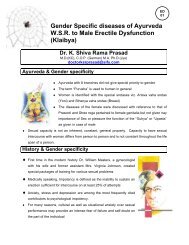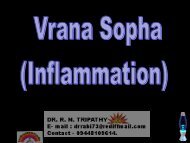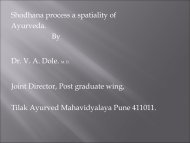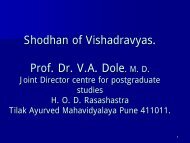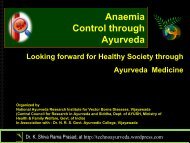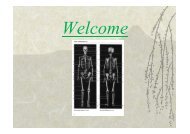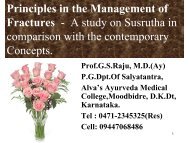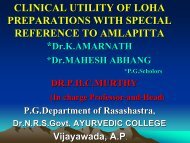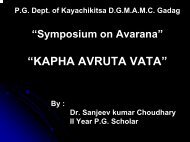Pittadhara Kala - Techno Ayurveda
Pittadhara Kala - Techno Ayurveda
Pittadhara Kala - Techno Ayurveda
- No tags were found...
Create successful ePaper yourself
Turn your PDF publications into a flip-book with our unique Google optimized e-Paper software.
HAVE<br />
Knowledge<br />
Clinical importance of<br />
<strong>Pittadhara</strong> <strong>Kala</strong><br />
Guest lecture at AMC, Davangere<br />
Dr. K. Shiva Rama Prasad<br />
M.D.(KC), M.A, Ph.D (Jyo)<br />
doctorksrprasad@gmail.com 1
Need to know<br />
<strong>Kala</strong> are very much neglected in the clinical<br />
medicine<br />
<strong>Kala</strong> possess major importance in the body<br />
Many diseases of present day are specifically<br />
<strong>Kala</strong> concern, such as –<br />
Grahani (<strong>Pittadhara</strong>kala)<br />
Durmedas (Medodhara<br />
<strong>Kala</strong>)<br />
Infertility (Sukra(<br />
dhara kala)<br />
Musculo skeletal problems (Mamsadhara(<br />
kala)<br />
I.B.S ( Pureeshadhara kala) ) etc.<br />
doctorksrprasad@gmail.com<br />
2
Many a times we never think of<br />
understanding the structural disturbances<br />
in the body and rectification of the<br />
structural integrity disturbed by the dosha<br />
in the body<br />
Apart from the rectification and<br />
pacification of the dosha out of srotodusti<br />
lakshana – Atipravrutti & Apravrutti<br />
(Sanga) – Sira granthi & Vimargagamana<br />
are essential to examine in detail<br />
Rectify the structural and functional<br />
disturbances of <strong>Kala</strong> With special<br />
reference to Kayachikitsa<br />
doctorksrprasad@gmail.com<br />
3
<strong>Pittadhara</strong> <strong>Kala</strong><br />
Pitta & Agni<br />
Ama<br />
Ama Pradoshaja<br />
<strong>Pittadhara</strong> kala Janya Vyadhi<br />
<strong>Pittadhara</strong> <strong>Kala</strong> Chikitsa<br />
doctorksrprasad@gmail.com<br />
4
Saptakala Vijnana<br />
<strong>Kala</strong> are seven in number<br />
<strong>Kala</strong> lies in between the Dhatu and<br />
Ashaya<br />
<strong>Kala</strong> are like pith of the steam in the<br />
Tissues<br />
MüsÉÉ: ZÉsuÉÌmÉ xÉmiÉxÉqpÉuÉÎliÉ kÉÉiuÉÉvÉrÉÉliÉU qÉrÉÉïSÉ:<br />
rÉjÉÉ ÌWû xÉÉU: MüɹåwÉÑÎccɱqÉÉlÉåwÉÑ SìÓvriÉå - xÉÑ.vÉÉ 4/5<br />
doctorksrprasad@gmail.com<br />
5
<strong>Kala</strong> Nomenclature<br />
‣ The fluid between the Dhatu<br />
and Ashaya subjected to the<br />
heat developed from Ushma<br />
gives rise the <strong>Kala</strong><br />
‣ The <strong>Kala</strong> is covered by the<br />
layer of phlegm<br />
kÉÉiuÉÉvÉrÉÉliÉUYsÉåS: ÌuÉmÉYuÉ: xuÉÇ xuÉqÉÔwqÉhÉÉ vsÉåwqÉ<br />
xlÉÉruÉmÉUÉcNû³É: MüsÉÉZrÉ: MüɹxÉÉUuÉiÉç, iÉÉxxÉmiÉ –<br />
A.¾Òû.vÉÉ 3/9<br />
doctorksrprasad@gmail.com<br />
6
<strong>Kala</strong> Division<br />
1) Mamsadhara kala<br />
2) Raktadhara kala<br />
3) Medodhara kala<br />
4) Shleshmadhara kala<br />
5) Pureeshadhara kala<br />
6) <strong>Pittadhara</strong> kala<br />
7) Shukradhara kala<br />
doctorksrprasad@gmail.com<br />
7
Difference of opine<br />
<strong>Kala</strong> is defined as a layer between – Rasa-<br />
Rakta – Mamsa – Medo- Asti – Majja –<br />
Shukra, , 7 dhatu and Vata – Pitta – Shleshma<br />
– Ama – Mala – Mootra – Raktashaya of 7<br />
Ashayas<br />
2 nd opine is – dhatu means Mamsa – Rakta –<br />
Medas – Shleshma and Sukra along with the<br />
Ashaya as Pittashaya, , Pakwashaya.<br />
Both of the above are considered & needs<br />
further discussion to specify any one of them<br />
doctorksrprasad@gmail.com<br />
8
<strong>Pittadhara</strong> <strong>Kala</strong><br />
<strong>Pittadhara</strong> <strong>Kala</strong> is 6 th in order<br />
Receives when the food is propelled from<br />
Amashaya Holds in the Pakwashaya -<br />
The four verities of food ingested – viz.<br />
Asita, Khadiata, Peeta and Leeda<br />
wɹÏÌmɨÉkÉUÉ lÉÉqÉ, rÉÉ cÉiÉÑÌuÉïkÉqɳÉmÉÉlÉqÉÑmÉrÉÑ£ü<br />
qÉÉqÉÉvÉrÉÉimÉëcrÉÑiÉÇ mÉYuÉÉvÉrÉÉåmÉÎxjÉiÉÇ kÉÉUrÉÌiÉ -<br />
xÉÑ.vÉÉ 4/17<br />
doctorksrprasad@gmail.com<br />
9
Structural Aspect of<br />
<strong>Pittadhara</strong> <strong>Kala</strong><br />
In between Pakwashaya and Amashaya<br />
Holds the food at Pakwashaya<br />
These statements refer to the activity<br />
concern and states that the <strong>Pittadhara</strong> kala is<br />
as such below to that of the Ashaya which<br />
holds the undigested food and in the Ashaya<br />
which propels the digested food for<br />
absorption With the function of assimilation<br />
mÉYuÉÉqÉÉvÉrÉqÉkrÉxjÉÉaÉëWûhÉÏ mÉËUMüÐÌiÉïiÉÉ –<br />
AÉqÉÉvÉrÉÉimÉëcrÉÑiÉÇ mÉYuÉÉvÉrÉÉåmÉÎxjÉiÉÇ kÉÉUrÉÌiÉ -<br />
xÉÑ.vÉÉ 4/17 doctorksrprasad@gmail.com<br />
10
As the Sigmoid colon<br />
and Rectum are<br />
termed with “Pureesha<br />
Vaha srotas” and lined<br />
by “Pureeshadhara<br />
<strong>Kala</strong>” – these parts of<br />
GIT are ruled out of<br />
the discussion of<br />
pittadharakala<br />
doctorksrprasad@gmail.com<br />
11
From mouth till to and in the<br />
Amashaya – 4 food varieties<br />
are passed in undigested form<br />
– thus comfortably can be<br />
termed as Amashaya<br />
doctorksrprasad@gmail.com<br />
12
Consideration of Amashaya<br />
Amashaya is with undigested food<br />
Contemporary science explains as –<br />
carbohydrate digestion starts at mouth and<br />
protein at stomach and fats at duodenum<br />
As the fat digestion is continued till to that of<br />
Jejunum – it has to be considered even the<br />
duodenum is also as a part of Amashaya<br />
Even at the Jejunum, absorption doesn’t t takes<br />
place thus till to that of Ileum jejunum junction –<br />
Amashaya extends<br />
doctorksrprasad@gmail.com<br />
13
The part between<br />
Jejunum and Sigmiod<br />
colon is the Ileum –<br />
Pakwa-Amashaya<br />
madhya is the part<br />
anatomically to consider<br />
as Grahani or<br />
<strong>Pittadhara</strong> <strong>Kala</strong><br />
doctorksrprasad@gmail.com<br />
14
Functional Aspect of<br />
<strong>Pittadhara</strong>kala<br />
It digests the 4 verities of food<br />
Digestion in terms of – Pachana –<br />
Vivechana – Mumchana<br />
All the functions of Pitta are attributed to<br />
<strong>Pittadhara</strong>kala based on the concept of<br />
Adhara-Adheya<br />
Adheya bhava. . The integrity of<br />
the <strong>Pittadhara</strong> kala (Grahani)) depends<br />
upon the proper function of Agni so it can<br />
be termed as even “Agnidhra<br />
<strong>Kala</strong>”<br />
aÉëWûhrÉÉoÉsÉqÉÎalÉÌWïû ---- iÉxqÉÉSalÉå mÉëSÕÌwÉiÉå aÉëWûhÉÏ<br />
xÉÇmÉëSÕwrÉiÉÏÌiÉ- xÉÑ.E¨ÉU- QûsWûhÉ 40/170<br />
doctorksrprasad@gmail.com<br />
15
Enumeration & Examination<br />
of Functions<br />
Functions of <strong>Pittadhara</strong>kala are enumerated by -<br />
Grahana - collection (Grahana<br />
<strong>Pittadhara</strong>kala - Amashayastha)<br />
Pachana - digestion (Pachana<br />
<strong>Pittadhara</strong>kala - Pachyamanashayastha)<br />
Vivechana & Mumunchana – Separation<br />
& Absorption (Vivechana<br />
<strong>Pittadhara</strong>kala<br />
- Pakwashayastha)<br />
doctorksrprasad@gmail.com<br />
16
Grahana - collection<br />
The collection anomalies (Functional or<br />
Organic) are subjected to the movements<br />
of the stomach to make the food as<br />
amalgam and<br />
To initiate the normal peristaltic<br />
movements in the intestines<br />
Main diseases pertained are of Grahani<br />
roga – Kosta stabdhata - sroto sanga<br />
(carcinoma, etc) - etc,. Even Dosha wise<br />
diseases can be enumerated<br />
doctorksrprasad@gmail.com<br />
17
Pachana - digestion<br />
The digestion disturbances are well<br />
narrated in <strong>Ayurveda</strong> and many Agni inter<br />
linked diseases are explained<br />
To initiate the normal Agni, examination of<br />
Agni is necessary<br />
Main diseases pertained to Agni are -<br />
Agnimandya,<br />
Ajeerna,<br />
Parinama<br />
shoola, Annadrava shoola, , etc,.<br />
doctorksrprasad@gmail.com<br />
18
Summary of<br />
chemical<br />
events in<br />
digestion<br />
doctorksrprasad@gmail.com<br />
19
Vivechana & Mumunchana<br />
– Separation & Absorption<br />
Water, electrolytes, and vitamins can be<br />
absorbed without preliminary processing, but<br />
special transport mechanisms are commonly<br />
involved.<br />
The intestinal epithelium then absorbs the<br />
monosaccharides by facilitated diffusion and<br />
cotransport mechanisms.<br />
cells lining the small intestine will continue to<br />
absorb glucose when glucose concentrations<br />
inside the cells are much higher than they are in<br />
the intestinal contents.<br />
doctorksrprasad@gmail.com<br />
20
triglycerides, in company with absorbed<br />
steroids and phospholipids, are then coated<br />
with proteins, creating complexes known as<br />
chylomicrons<br />
amino acids, as well as those produced by<br />
the pancreatic enzymes, are absorbed<br />
through both facilitated diffusion and<br />
cotransport mechanisms<br />
The anions chloride, iodide, bicarbonate, and<br />
nitrate may be absorbed through diffusion or<br />
carrier-mediated transport. Phosphate and<br />
sulfate ions enter epithelial cells only<br />
through active transport.<br />
doctorksrprasad@gmail.com<br />
21
Here I wish to make a comment<br />
<strong>Ayurveda</strong> and Contemporary medicines are<br />
appropriative and doesn’t t fit one to another as<br />
like Relative theory and Quantum theory<br />
<strong>Ayurveda</strong> is like a Relative theory of Einsteen,<br />
which speaks about the “G” – Gravity<br />
On the other hand – contemporary medical<br />
sciences speak of Quantum theory of –<br />
Electromagnetism, Strong force and Weak force<br />
A major exercise is necessary to understand and<br />
bind the two poles of Health sciences<br />
doctorksrprasad@gmail.com<br />
22
Secretion and<br />
water<br />
absorption in<br />
the Digestive<br />
tract - suggests<br />
the placement<br />
of the<br />
<strong>Pittadhara</strong><br />
<strong>Kala</strong><br />
physiologically<br />
after the<br />
Duodenum<br />
and before to<br />
the Ileoceacal<br />
Valve<br />
<strong>Pittadhara</strong> <strong>Kala</strong><br />
Pureeshadhara<br />
<strong>Kala</strong><br />
doctorksrprasad@gmail.com<br />
23
<strong>Pittadhara</strong> <strong>Kala</strong><br />
Pitta & Agni<br />
Ama<br />
Ama Pradoshaja<br />
<strong>Pittadhara</strong> kala Janya Vyadhi<br />
<strong>Pittadhara</strong> <strong>Kala</strong> Chikitsa<br />
doctorksrprasad@gmail.com<br />
24
Examination of Pitta & Agni<br />
There is no other Agni available in the<br />
body other than that of Pitta 1<br />
Agni is examined by the “Jarana<br />
shakti”<br />
Jarana Shakti is the capacity of digestion<br />
in terms of food taken under the<br />
stipulations and norms<br />
For this only questionnaire are sufficient<br />
Few of the concern terms are -<br />
1 lÉZÉsÉÑ ÌmɨÉurÉÌiÉUåMüÉSlrÉÉåÅÎalÉÂmÉsÉprÉiÉå - xÉÑ.xÉÔ.21/8<br />
doctorksrprasad@gmail.com<br />
25
Food in connection with<br />
digestion<br />
Aahaarasakti<br />
(Pachana <strong>Pittadhara</strong> kala)<br />
means the capacity to the intake of food and<br />
digestion<br />
How much a person can consume food without<br />
any discomfort is considered as<br />
Abhyavaharana sakti (Grahana<br />
<strong>Pittadhara</strong><br />
kala)<br />
The proper digestion of food in time with out any<br />
discomfort is considered as the capacity of his<br />
digestion is Jarana sakti (Vivechana<br />
<strong>Pittadhara</strong> kala)<br />
doctorksrprasad@gmail.com<br />
26
AVIPAAKAH (Indigestion) is<br />
resultant of improper Agni<br />
Ajarakam<br />
Ajeernam<br />
Apaakah<br />
Apaktisaktih<br />
Paktinaasah are the synonyms of<br />
Avipaka.<br />
doctorksrprasad@gmail.com<br />
27
Impaired <strong>Pittadhara</strong> <strong>Kala</strong> means<br />
impaired Agni and development<br />
of Ama<br />
Ama Produces at GIT and also in Dhatus<br />
at Biochemical expression Ama can be<br />
• Improperly metabolized intermediate byproducts<br />
• Increased antigenicity<br />
• Free radicals<br />
doctorksrprasad@gmail.com<br />
28
<strong>Pittadhara</strong> <strong>Kala</strong><br />
Pitta & Agni<br />
Ama<br />
Ama Pradoshaja<br />
<strong>Pittadhara</strong> kala Janya Vyadhi<br />
<strong>Pittadhara</strong> <strong>Kala</strong> Chikitsa<br />
doctorksrprasad@gmail.com<br />
29
Ama Definition<br />
By definition Ama is -<br />
Apakwa Ahara - undigested food<br />
Shukta Ahara - fermented food<br />
Visharoopa Ahara - toxic like food<br />
Mala sanchaya - eliminative accumulation<br />
Ahara rasa shesha - left of rasa in<br />
Amashaya<br />
first stage of Dosha Dusti<br />
AmÉcrÉqÉÉlÉÇ vÉÑ£üiuÉÇ rÉÉirɳÉÇ ÌuÉwÉÃmÉiÉÉqÉç - cÉ.ÍcÉ.15/42<br />
doctorksrprasad@gmail.com<br />
30
Enumeration and Examination of Ama<br />
It is difficult to enumerate quantitatively Ama in<br />
clinical aspect<br />
But it is not an Impossible task<br />
The normal terms come across are - Ushma -<br />
Adyadhatu and Amashaya<br />
Here the Ushma - Heat is the concern<br />
Ushma maintenance is done by Pitta of<br />
Amashaya (Pachakapitta) and Pitta of Twak<br />
(Bhrajakapitta)<br />
So, to examine Ama clinically is possible by<br />
examining the contextual Ama Lakshana and<br />
Twak<br />
doctorksrprasad@gmail.com<br />
31
Ama Lakshana (A.H.Su.13/24)<br />
Srotorodha - obstruction to channels<br />
Balabhramsha - loss of strength<br />
Gourava - heaviness<br />
Anila moodhata - loss of impulses<br />
Aalasya - laziness<br />
Apakti - loss of digestion<br />
Nisteeva -spitting<br />
Malasanga - accumulation of waste<br />
Aruchi - tastelessness<br />
Klama - fatigue -<br />
out of these except Srotorodha, Anila Moodhata and<br />
Malasanga rest are self explainable<br />
doctorksrprasad@gmail.com<br />
32
Srotorodha examination<br />
Out of the 13 srotas explained each and<br />
every srotas are individually examined<br />
along with specificity of Rasa and Rakta<br />
as they are related to pittadharakala<br />
directly.<br />
Any Atipravrutti - Apravrutti with reference to<br />
functions and<br />
Sira Granthi and Vimarga Gamana with the<br />
structure is considered<br />
doctorksrprasad@gmail.com<br />
33
Malasanga examination<br />
Mala are Pureesha - Mootra - Sweda<br />
at present context <strong>Pittadhara</strong> <strong>Kala</strong> separates the Mala<br />
and Sara in general is impaired to accumulate the Mala<br />
and obstructs or<br />
another understanding is the mala which is formed is not<br />
separated by the <strong>Pittadhara</strong> <strong>Kala</strong><br />
The Mala are - biological end products which interfere<br />
the digestion and metabolism -<br />
eg. Enteroendocrine cells (Glands in the pylorus)<br />
produce at least seven different hormones, most notably<br />
the hormone gastrin (G cells) in the gastric pits of the<br />
pyloric antrum. The pyloric glands also contain D cells,<br />
which release somatostatin a hormone that inhibits<br />
gastrin release.<br />
doctorksrprasad@gmail.com<br />
34
Anila Moodhata examination<br />
The neural output proceeds via the<br />
parasympathetic division of the ANS and reaches<br />
the stomach by means of the vagus nerves<br />
As par <strong>Ayurveda</strong> - the Vata (Samana) in the Kosta<br />
is responsible for the Anna Grahana, Pachana,<br />
Vivechana<br />
thus the Kostashrita Vata is much clinically<br />
evaluated<br />
When Vagatomy or any surgical procedures under<br />
taken impulsive nerve reflexes lessens the<br />
enzymatic secretion in the Stomach or vice versa<br />
doctorksrprasad@gmail.com<br />
35
Skin in the examination of Ama<br />
The importance of the Twacha should not<br />
be forgotten as the “Ushma” is regulated<br />
by the it self<br />
Skin respires even<br />
the examination of Twacha includes with<br />
the - temperature variances, Temperature<br />
disturbances over the enzyme secretions<br />
and digestion<br />
doctorksrprasad@gmail.com<br />
36
Twak Gourawa, Twak Rodhata, Prabha-<br />
Chaya nasha, twakgata vata (Vyana)<br />
karma hani, , Non absorbability of skin, skin<br />
fatigue, Depositions of eliminative<br />
materials (Malasanga(<br />
Malasanga) – sweda abhavata<br />
– are common conditions of Ama in Twak<br />
At the time of Abhyanga - the Drug<br />
designated is absorbed and assimilated<br />
well by the Skin is witnessed as an<br />
example through Bhrajaka Pitta (Agni)<br />
doctorksrprasad@gmail.com<br />
37
Clinical Identification of Ama<br />
Where ever Ama is seated there -<br />
Sthambha - immobility<br />
Gourava - Heaviness<br />
Staneeya Deha Vishesha Vikara<br />
Dosha vishesha Saama Lakshana<br />
Dhatu vishesha Saama Lakshana -<br />
are seen<br />
doctorksrprasad@gmail.com<br />
38
<strong>Pittadhara</strong> <strong>Kala</strong><br />
Pitta & Agni<br />
Ama<br />
Ama Pradoshaja <strong>Pittadhara</strong><br />
kala Janya Vyadhi<br />
<strong>Pittadhara</strong> <strong>Kala</strong> Chikitsa<br />
doctorksrprasad@gmail.com<br />
39
Ama Pradoshaja Vyadhi<br />
If spreads upward - Vishuchika<br />
If spreads down ward - Alasaka<br />
with the Ajeerna it is called as Amavisha<br />
Amadosha, Amavatagrahani (Sangraha<br />
grahani),<br />
Amavata, , etc are considered as<br />
Amaja Vyadhi<br />
Apart from all the basic definition of<br />
“Amaya” includes all diseases in Ama<br />
with special reference to the <strong>Pittadhara</strong><br />
<strong>Kala</strong> Janya vydhi<br />
doctorksrprasad@gmail.com<br />
40
Vardhakya & <strong>Pittadhara</strong> <strong>Kala</strong><br />
AGING AND THE DIGESTIVE SYSTEM<br />
The rate of epithelial stem cell division<br />
declines<br />
The digestive epithelium becomes more<br />
susceptible to damage by abrasion, acids, or<br />
enzymes. Amlapitta, Parinama Shoola etc, Acid<br />
Peptic disorders, therefore become more likely.<br />
In the mouth, esophagus, and anus, the stratified<br />
epithelium (<strong>Pittadhara</strong> <strong>Kala</strong>) becomes thinner<br />
and more fragile.<br />
doctorksrprasad@gmail.com<br />
41
Smooth muscle tone decreases<br />
General motility decreases (Anila<br />
Moodhata), and peristaltic contractions<br />
are weaker.<br />
These changes slow the rate of fecal<br />
movement and promote constipation<br />
(Malasanga)<br />
Sagging and inflammation of the haustra<br />
in the colon can produce symptoms of<br />
diverticulosis (Vimargagamana)<br />
doctorksrprasad@gmail.com<br />
42
Straining to eliminate compacted fecal<br />
materials can stress the less-resilient walls<br />
of blood vessels, producing hemorrhoids<br />
(Arshas)<br />
Problems are not restricted to the lower<br />
digestive tract. For example, weakening of<br />
muscular sphincters can lead to esophageal<br />
reflux and frequent bouts of "heartburn."<br />
(Apakti-Amlodgara)<br />
doctorksrprasad@gmail.com<br />
43
The effects of cumulative damage become<br />
apparent<br />
A familiar example is the gradual loss of teeth<br />
due to dental caries or gingivitis.<br />
Cumulative damage can involve internal organs<br />
as well.<br />
Toxins (visha) such as alcohol and other<br />
injurious chemicals that are absorbed by the<br />
digestive tract are transported to the liver for<br />
processing (Bhutagnipaka). The cells of the liver<br />
are not immune to these toxic compounds, and<br />
chronic exposure can lead to cirrhosis or other<br />
types of liver disease.<br />
doctorksrprasad@gmail.com<br />
44
Cancer rates increase. Not surprisingly, cancers<br />
are most common in organs in which stem cells<br />
divide to maintain epithelial cell populations. Rates<br />
of colon cancer and stomach cancer rise in the<br />
elderly; oral and pharyngeal cancers are particularly<br />
common among elderly individuals who smoke.<br />
Changes in other systems have direct or indirect<br />
effects on the digestive system. For example, the<br />
reduction in bone mass and calcium content in<br />
the skeleton is associated with erosion of the tooth<br />
sockets and eventual tooth loss.<br />
The decline in olfactory and gustatory sensitivity<br />
with age can lead to dietary changes that affect the<br />
entire body.<br />
doctorksrprasad@gmail.com<br />
45
Ama (Mandagni) Nadi<br />
Ajeerna, Ama Dosha, invasion of Fever,<br />
Appetite, Vitiated Vata, Pitta and Kapha<br />
are known by the Hasta Nadi - Basava<br />
Rajeeyam<br />
AeÉÏhÉïqÉÉqÉ SÉåwÉÇcÉ euÉUxrÉaÉqÉlÉÇ ¤ÉÑjÉÉÇ, uÉÉiÉÌmɨÉMüTüÉlÉç<br />
SÒ¹ÉlÉç WûxiÉlÉÉQûÏ ÌlÉSvÉïrÉåiÉç - oÉxÉuÉUÉeÉÏrÉqÉç<br />
doctorksrprasad@gmail.com<br />
46
Agnimandya and<br />
Grahani roga Nadi<br />
At Mandagni Nadi is always slow<br />
like a Swan – but<br />
in Agnimandya and Grahani roga<br />
(<strong>Pittadhara</strong> <strong>Kala</strong> vikruti) Nadi at feet<br />
is like swan- slow, rhythmic<br />
(Mandagni Nadi) and at hand like a<br />
frog - jumping<br />
qÉÇSÉalÉÉæ ¤ÉÏhÉiÉÉÇ rÉÉÌiÉ lÉÉQûÏ WûÇxÉÉ¢ÑüÌiÉxiÉjÉÉ<br />
mÉÉSåcÉ WûÇxÉaÉqÉlÉÉ MüUå qÉÇQÕûMüxÉÇmsÉuÉÉ<br />
iÉxrÉÉalÉåUÇSiÉÉ SåWåûiuÉkÉuÉÉ aÉëWûhÉÏ aÉS:- lÉÉQûÏlɤɧÉqÉÉsÉ<br />
doctorksrprasad@gmail.com<br />
47
<strong>Pittadhara</strong> <strong>Kala</strong><br />
Pitta & Agni<br />
Ama<br />
Ama Pradoshaja<br />
<strong>Pittadhara</strong> kala Janya Vyadhi<br />
<strong>Pittadhara</strong> <strong>Kala</strong> Chikitsa<br />
doctorksrprasad@gmail.com<br />
48
Normal patterns of Management<br />
Nidana Parivarjana<br />
Pachana<br />
Deepana<br />
snehana<br />
swedana<br />
Shodhana<br />
Are they sufficient to combat<br />
<strong>Pittadhara</strong> <strong>Kala</strong> Disease, which is<br />
deep rooted, wide spread and<br />
embedded with Ama<br />
doctorksrprasad@gmail.com<br />
49
ÌmɨÉkÉUÉMüsÉÉ<br />
ÉÉ LuÉqÉç<br />
Éç qÉeeÉÉkÉUÉMüsÉÉ<br />
Pitta vs Vata<br />
The contextual thoughts of the<br />
interference of Vata and Majjadhara kala<br />
makes panic to one – who wish to treat<br />
Ama in Vata Vyadhi (Pakshaghata(<br />
Pakshaghata)<br />
As already it is discussed about Ca+<br />
absorption from the Ileum (<strong>Pittadhara</strong><br />
<strong>Kala</strong>) is the right answer – that the Ca+<br />
interference with the synape at Neuro-<br />
muscular junctions makes to either vitiate<br />
or pacify the vata (Expressional)<br />
doctorksrprasad@gmail.com<br />
50
Anulomana (Minor purgation) is the<br />
treatment for the Vata and Virechana<br />
(Major purgation) for that of Pitta and<br />
based upon Ashrayasrayee bhava<br />
even to that of the <strong>Pittadhara</strong> <strong>Kala</strong><br />
Thus it is evident that the Ama of<br />
<strong>Pittadhara</strong> kala can be nullified<br />
appropriately used “Virechana<br />
–<br />
elimination” along with Deepana and<br />
Pachana<br />
doctorksrprasad@gmail.com<br />
51
The present discussion opens new<br />
thoughts as such –<br />
No specific patterns of treatment is used to<br />
eliminate the “<strong>Pittadhara</strong><br />
kala” associated<br />
diseases of either exclusively structural or<br />
of functional<br />
Apart from above problem – Uthana and<br />
Leena Ama dosha is also seated<br />
Amashaya/Pakwashaya (<strong>Pittadhara</strong>(<br />
<strong>Kala</strong>)<br />
and Dhatus respectively<br />
doctorksrprasad@gmail.com<br />
52
As the problems of Grahana –<br />
Pachana – Vivechana –<br />
Mumunchana are individual; at a<br />
streach management is not<br />
adoptable<br />
What to do then<br />
doctorksrprasad@gmail.com<br />
53
Deepaneya<br />
– Churna<br />
– Arista<br />
– Ghruta – according to the<br />
situation has to be administered<br />
SÏmÉlÉÏrÉÉÌlÉ xÉuÉÉïÍ ÉÉïÍhÉ cÉÔh ÔhÉÉïË ÉÉïËU¹bÉëÑ ÉëÑiÉÉÌlÉ cÉ<br />
mÉë ÉëÌuÉpÉerÉ rÉjÉÉuÉxjÉÇ<br />
rÉÉå ÉÉåeÉrÉå ÉåSè èaÉë ÉëWû ûhÉÏaÉSå<br />
å – oÉxÉuÉ UÉeÉÏrÉqÉç<br />
Éç<br />
doctorksrprasad@gmail.com<br />
54
Agnikarma – will it be a good<br />
treatment<br />
It is told as when a disease of the<br />
<strong>Pittadhara</strong> <strong>Kala</strong> is not possible to be<br />
treated with normal protocols – adopt<br />
“Agnikarma”<br />
Agnikarma has to be performed at<br />
“Veenasti<br />
moola - Trika” or 2 inches below<br />
to the Umbilicus<br />
doctorksrprasad@gmail.com<br />
55
Forgotten but best even<br />
not available for the divine -<br />
The Buttermilk – Takram is the best<br />
for any of the <strong>Pittadhara</strong> kala janya<br />
Vikara<br />
This is not Lassi – A shaken Curd<br />
Butter milk is to be prepared with<br />
always with 1 part of curd to 4 parts of<br />
water churned well and filtered with a<br />
cloth and with Hingu, Jeera,<br />
Saindhava, Sarshapa (Bhava<br />
Prakasha)<br />
doctorksrprasad@gmail.com<br />
56
Kayasya Antaragni chikitsa is Kayachikitsa<br />
Agni and Pitta are similar according to<br />
Susruta<br />
No other Agni is available in the body<br />
other than that of Pitta<br />
<strong>Pittadhara</strong> <strong>Kala</strong> associates with Pitta<br />
Pitta management is adoptable for<br />
<strong>Pittadhara</strong> kala Diseases even<br />
Proper care of <strong>Pittadhara</strong> <strong>Kala</strong> can prevent<br />
the Dosha Vitiation and Disease<br />
manifestation<br />
doctorksrprasad@gmail.com<br />
57
Amashayastha Grahana <strong>Pittadhara</strong>kala<br />
– in comparison with the intrinsic factor<br />
is having the Rakta kala maryada<br />
(Blood)<br />
Pachyamanashayastha Pachana<br />
<strong>Pittadhara</strong>kala has the relation with the<br />
Rasa <strong>Kala</strong> Maryada<br />
Pakwashayastha Vivechana<br />
<strong>Pittadhara</strong>kala establishes the<br />
relationship with Majja kala maryada by<br />
absorbing Ca+<br />
The kala maryada is used to establish<br />
the disease entity to treat appropriately<br />
doctorksrprasad@gmail.com<br />
58
After hearing all one has to decide what<br />
management protocol is to be adopted<br />
for an individual disease entity of<br />
<strong>Pittadhara</strong> <strong>Kala</strong> at the interference of<br />
Dosha and Ama in the continuity of<br />
Amashaya – Annavaha srotas and<br />
beginning of the Pakwashaya -<br />
Pureesha Vaha srotas –<br />
Pureeshadhara <strong>Kala</strong> – appropriately<br />
according to the situation and the<br />
symptomatology<br />
doctorksrprasad@gmail.com<br />
59
HAVE<br />
Knowledge<br />
mÉëÑccÉMåülÉ ÍvÉwrÉÉæ xÉÇvÉrÉÌlÉuÉëѨÉåÅÌmÉ aÉÑÂ:<br />
aÉÑÂ ÌuÉlÉ lÉ ÍvÉwrÉÉ: ÍvÉwrÉÌuÉlÉÉ lÉ aÉÑÂ<br />
Haral’s Academy of Vedic<br />
Education, Hyderabad<br />
doctorksrprasad@gmail.com<br />
60
It is from<br />
HAVE<br />
Knowledge<br />
doctorksrprasad@sify.com<br />
doctorksrprasad@gmail.com<br />
61




